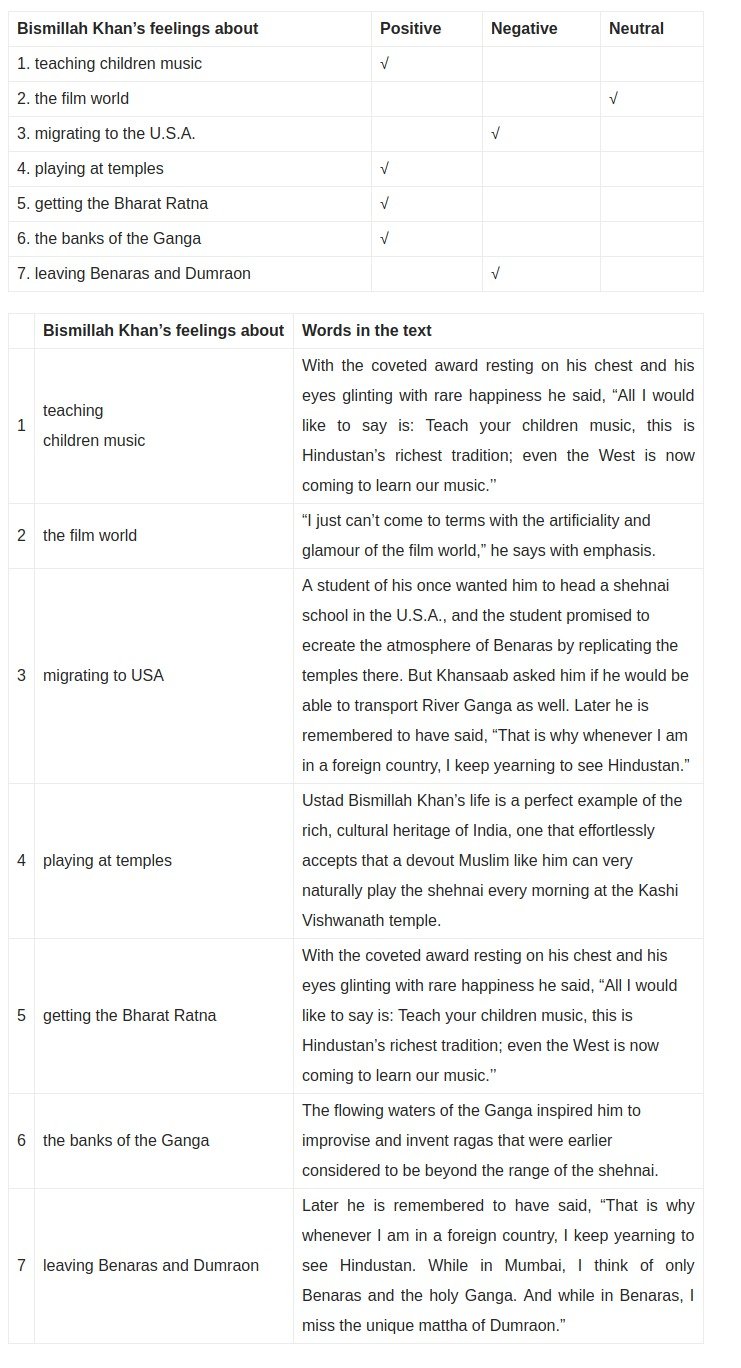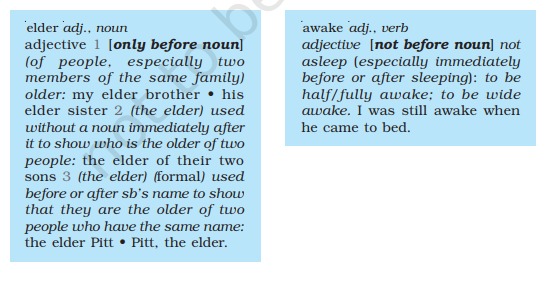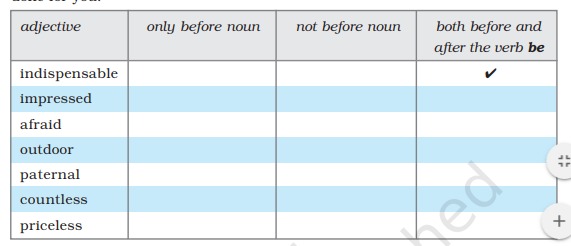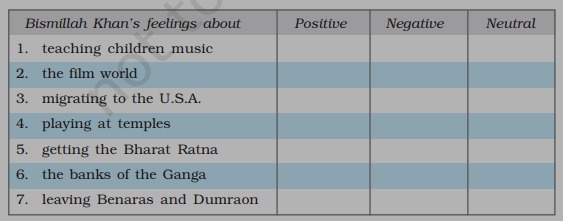Chapter - 2 "The Sound of Music"
Q.I: Answer these questions in a few words or a couple of sentences each.
1. How old was Evelyn when she went to the Royal Academy of Music?
2. When was her deafness first noticed? When was it confirmed?
Ans : 1. Evelyn was seventeen years old when she went to the Royal Academy of Music in London. 2. Her deafness was first noticed by her mother when Evelyn was eight years old. She was once waiting to play the piano. When her name was called, she did not move. That was when her mother realized that Evelyn had not heard anything. Her deafness was confirmed when she was eleven. Her marks had deteriorated and her headmistress had urged her parents to take her to a specialist. It was then discovered that gradual nerve damage had severely impaired her hearing.
Q.II: Answer each of these questions in a short paragraph (30–40 words).
1. Who helped her to continue with music? What did he do and say?
2. Name the various places and causes for which Evelyn performs.
Ans : 1. Percussionist Ron Forbes was the first person to notice Evelyn's potential. He began by tuning two large drums to different notes. He asked Evelyn not to listen through her ears but to try and sense the sound in some other manner. Suddenly Evelyn realized that she could feel the higher drum from the waist up and the lower drum from the waist down. Forbes repeated the exercise and Evelyn realized that she could sense certain notes in different parts of her body. 2. Evelyn always delighted her audience. She had toured the United Kingdom with a youth orchestra. She had a very hectic international schedule. Apart from the regular concerts, she gave free concerts in prisons and hospitals. She gave high priority to classes for young musicians because of which she was a shining inspiration for deaf children.
Q.III: Answer the question in two or three paragraphs (100–150 words).
1. How does Evelyn hear music?
Ans : Evelyn heard music by sensing the notes in different parts of her body. When Ron Forbes tuned two drums and asked her to sense the sound without using her ears, she realized that she could feel the higher drum from the waist up and the lower drum from the waist down. When she played the xylophone, she could sense the sound passing up the stick into her fingertips. By leaning against the drums, she could feel the resonances flowing into her body. On a wooden platform, she removed her shoes so that the vibrations could pass through her bare feet. She herself said that music poured in through every part of her body. It tingled in the skin, her cheekbones and even in her hair.
Q.I: Tick the right answer.
1. The (shehnai, pungi) was a ‘reeded noisemaker.’
2. (Bismillah Khan, A barber, Ali Bux) transformed the pungi into a shehnai.
3. Bismillah Khan’s paternal ancestors were (barbers, professional musicians).
4. Bismillah Khan learnt to play the shehnai from (Ali Bux, Paigambar Bux, Ustad Faiyaaz Khan).
5. Bismillah Khan’s first trip abroad was to (Afghanistan, U.S.A., Canada).
Ans : 1. The pungi was a 'reeded noisemaker.' 2. A barber transformed the pungi into a shehnai. 3. Bismillah Khan's paternal ancestors were professional musicians. 4. Bismillah Khan learnt to play the shehnai from Ali Bux. 5. Bismillah Khan's first trip abroad was to Afghanistan.
Q.II: Find the words in the text which show Ustad Bismillah Khan’s feelings about the items listed below. Then mark a tick (✓) in the correct column. Discuss your answers in class.
Ans :
Q.III: Answer these questions in 30–40 words.
1. Why did Aurangzeb ban the playing of the pungi?
2. How is a shehnai different from a pungi?
3. Where was the shehnai played traditionally? How did Bismillah Khan change this?
4. When and how did Bismillah Khan get his big break?
5. Where did Bismillah Khan play the shehnai on 15 August 1947? Why was the event historic?
6. Why did Bismillah Khan refuse to start a shehnai school in the U.S.A.?
7. Find at least two instances in the text which tell you that Bismillah Khan loves India and Benaras.
Ans : 1. Emperor Aurangzeb banned the playing of the pungi in the royal residence for it had a shrill and unpleasant sound. It became the generic name for reeded noisemakers. 2. Shehnai is a pipe with a natural hollow stem that is longer and broader than the pungi. It has seven holes on its body. When it is played, the closing and opening of some of the holes produces soft and melodious sounds. 3. Traditionally, the shehnai was part of the traditional ensemble of nine instruments found at royal courts. It was used only in temples and weddings. However, Ustad Bismillah Khan brought in the change by bringing it onto the classical stage. 4. Bismillah Khan had accompanied his uncle to the Allahabad Music Conference at the age of fourteen. At the end of his recital, Ustad Faiyaz Khan patted his back and told him to work hard and he shall make it big in life. He got his big break with the opening of the All India Radio in Lucknow in 1938. He soon became an often-heard shehnai player on radio. 5. On 15 August 1947, Bismillah Khan played the shehnai from the Red Fort. It was a historic day as India gained independence on that day. He became the first Indian to greet the nation with his shehnai. His audience included illustrious names such as Pandit Jawaharlal Nehru and Mahatma Gandhi. 6. Bismillah Khan refused to start a shehnai school in the U.S.A. because he could not live outside India. His student, who had asked him to head the shehnai school, promised that he would recreate the atmosphere of Benaras by replicating the temples in the city. However, he wanted to know if his student could also transport River Ganga, which his student obviously could not. He himself said that whenever he was in a foreign country', he kept yearning to see Hindustan. 7. Bismillah Khan immensely loved India, particularly Benaras and Dumraon. In his initial years, the temple of Balaji, Mangala Maiya, and the banks of River Ganga in Benaras became his favourite haunts where he could practice in peace and solitude. River Ganga's flowing waters inspired him to improvise and invent ragas that were once thought to be beyond the range of shehnai. Bismillah Khan refused to start a shehnai school in the U.S.A. because he could not live outside India. His student, who had asked him to head the shehnai school, promised that he would recreate the atmosphere of Benaras by replicating the temples in the city. However, he wanted to know if his student could also transport River Ganga, which his student obviously could not.
Q.I: Look at these sentences.
- Evelyn was determined to live a normal life.
- Evelyn managed to conceal her growing deafness from friends and teachers.
Ans : 1. The school sports team hopes to do better than the last time. 2. We all want to go on a vacation. 3. They advised the hearing-impaired child's mother to take her to a specialist. 4. The authorities permitted us to organize a charity event. 5. A musician decided to take India's music to the world.
Q.II: From the text on Bismillah Khan, find the words and phrases that match these definitions and write them down. The number of the paragraph where you will find the words/phrases has been given for you in brackets.
1. the home of royal people (1) ____________
2. the state of being alone (5) ____________
3. a part which is absolutely necessary (2) ____________
4. to do something not done before (5) ____________
5. without much effort (13) ____________
6. quickly and in large quantities (9) ____________ and ____________
Ans : 1. The home of royal people (1) the royal residence 2. The state of being alone (5) solitude 3. A part which is absolutely necessary (2) indispensable 4. To do something not done before (5) invent 5. Without much effort (13) effortlessly 6. Quickly and in large quantities (9) thick and fast
Q.III: Tick the right answer.
1. When something is revived, it (remains dead/lives again).
2. When a government bans something, it wants it (stopped/started).
3. When something is considered auspicious, (welcome it/avoid it).
4. When we take to something, we find it (boring/interesting).
5. When you appreciate something, you (find it good and useful/find it of no use).
6. When you replicate something, you do it (for the first time/for the second time).
7. When we come to terms with something, it is (still upsetting/no longer upsetting).
Ans : 1. When something is revived, it lives again. 2. When a government bans something, it wants it stopped. 3. When something is considered auspicious, welcome it. 4. When we take to something, we find it interesting. 5. When you appreciate something, you find it good and useful. 6. When you replicate something, you do it for the second time. 7. When we come to terms with something, it is no longer upsetting
Q.IV: Dictionary work
- The sound of the shehnai is auspicious.
- The auspicious sound of the shehnai is usually heard at marriages.
- Ustad Faiyaz Khan was overjoyed.
 Consult your dictionary and complete the following table. The first one has been done for you.
Consult your dictionary and complete the following table. The first one has been done for you.
 Use these words in phrases or sentences of your own.
Use these words in phrases or sentences of your own.
Ans :Indispensable– A nourishing food is indispensable for growing children. Impressed—All the countries of the world are impressed by Indian Democracy. I am not afraid of Mohan. Cricket is an outdoor game. He is my paternal uncle. Countless people have prayed in the temple. This painting is priceless.
Q.I: Imagine the famous singer Kishori Amonkar is going to visit your school. You have been asked to introduce her to the audience before her performance. How would you introduce her?
Here is some information about Kishori Amonkar you can find on the Internet. Read the passage and make notes of the main points about:
- her parentage
- the school of music she belongs to
- her achievements
- her inspiration
- awards
-
Padma Bhushan Kishori Amonkar, widely considered the finest female vocalist of her generation, was born in 1931, daughter of another great artist, Smt. Mogubai Kurdikar. In her early years she absorbed the approach and repertoire of her distinguished mother’s teacher Ustad Alladiya Khan. As her own style developed, however, she moved away from Alladiya Khan’s ‘Jaipur Atrauli gharana’ style in some respects, and as a mature artist her approach is usually regarded as an individual, if not unique, variant of the Jaipur model.
Kishori Amonkar is a thinker, besotted by what she calls the mysterious world of her raagas. She dissects them with the precision of a perfectionist, almost like a scientist, until the most subtle of shades and emotions emerge and re-emerge.
She is very much inspired by the teachings of the ancient Vedic sages, written at a time when vocal music was highly devotional in character. This soul searching quality of her music, coupled with a very intellectual approach to raaga performance has gained her quite a following in India and has helped to revive the study of khayal.
Significant awards bestowed on this artist include the Sangeet Natak Akademi Award (1985), the Padma Bhushan (1987), and the highly coveted Sangeet Samradhini Award (considered one of the most prestigious awards in Indian Classical Music) in 1997.
Ans : Good morning Teachers, Students and Everyone else present, Today, it is my pleasure to have amongst us here, Miss. Kishori Amonkar, the finest female vocalist of her generation. Born to one of India's music legends Mogubai Kudikar, Amonkar is a disciple of Sir. Ustad Alladiya Khan. Though trained by him in the 'Jaipur-Atrauli gharana' she soon moved onto explore music in her own individual ways. She is both intellectual and emotional in her approach to music. Inspired by Vedic teachings, her music has a soul-searching effect to it. She has been awarded the Padma Shri, Padma Bhushan, Sangeet Natak Akademi Award and Sangeet Samradhini Award, India's most prestigious awards in music. Let me please welcome you on stage to speak a few words, ma'am.
Q.II: Use your notes on Kishori Amonkar to introduce her to an imaginary audience. You may use one of the following phrases to introduce a guest:
I am honoured to introduce.../I feel privileged to introduce.../We welcome you...
Ans : I am honoured to introduce to you all Padma Bhushan Kishori Amonkar. She is the finest female vocalist . She is born in 1931. Her mother was a great artist Smt. Mogubai Kurdikar. She has her own style that is different in some respect from of Ustad Alladiya Khan's 'Jaipur- Atrauli gharana'. She is very much inspired by the teachings of the ancient Vedic sages. And her careful research of the raagas has lead her to recreate soul searching quality of her music and emotions through her music. She has honoured with many prestigious awards, which include the Sangeet Natak Akademi Award (1985), the Padma Bhushan (1987) and the highly coveted Sangeet Samradhini Award(consider one of the most prestigious awards in the Indian classical music (1997). We all are highly thankful to her for honouring us with her gracious presence.
Q.1: “If you work hard and know where you’re going, you’ll get there,” says Evelyn Glennie. You have now read about two musicians, Evelyn Glennie and Ustad Bismillah Khan. Do you think that they both worked hard? Where did they want to ‘go’? Answer these questions in two paragraphs, one on each of the two musicians.
Ans : Let me start by first of all looking at the life of Evelyn Glennie Evelyn Glennie: Evelyn is a 51 year old Scottish musician from Aberdeenshire, United Kingdom. What is actually surprising about her is the fact that she was increasingly getting deaf starting from the age of 12. However, that did not stop her from learning and enjoying music and she continued to play various western classical instruments. Throughout her career she has received more than a dozen awards Ustad Bismillah Khan: Ustad Bismillah Khan was born in Bihar in 1916, then British Indian Empire. He belonged to a long line of musicians in the family and even though he belonged to a strict Shia community which usually does not like music, he is today famous for single handedly making the 'Shenhai' a famous instrument in Indian pop and folk culture. He was eventually awarded India's highest civilian award
Q.I: 1. What are the things the wind does in the first stanza?
2. Have you seen anybody winnow grain at home or in a paddy field? What is the word in your language for winnowing? What do people use for winnowing? (Give the words in your language, if you know them.)
3. What does the poet say the wind god winnows?
4. What should we do to make friends with the wind?
5. What do the last four lines of the poem mean to you?
6. How does the poet speak to the wind — in anger or with humour? You must also have seen or heard of the wind “crumbling lives”. What is your response to this? Is it like the poet’s?
Ans : 1. In the first stanza, the wind shutters breaks the shutters of the windows, scatters the papers, throws down the books from the shelf, tears the pages of the books and brings showers of rain. 2. Yes, I have seen many women winnowing grain in villages. Pachhorana is the word in my language for winnowing. People use chaaj or winnowing fan for winnowing purpose. 3. The poet says that the wind god winnows the weak crumbling houses, doors, rafters, wood, bodies, lives and hearts, and then crushes them all. 4. To make friends with wind we need to build strong homes with firm doors. We should also make ourselves physically and mentally strong by building strong, firm bodies and having steadfast hearts. 5. In the last four lines, the poet inspires us to face the wind, which symbolises the hardships of our lives, courageously. He tells us that the wind can only extinguish the weak fires; it intensifies the stronger ones. Similarly, adversities deter the weak-hearted but make stronger those who have unfaltering will. In such a case, befriending the wind or the hardships of life makes it easier for us to face them. 6. The poet speaks to the wind with anger. Yes, strong winds are known to cause plenty of damage and destruction to both life and property. Storms, cyclones, gales and strong winds cause havoc on land. They uproot trees, bring down houses, tear down electric posts and claim lives. They also cause damage to boats and frighten the poor sailors and fishermen out at sea. Yet, I do not agree with the poet that the wind only crumbles lives'. The wind is responsible for bringing rain; it cools the land and makes the climate pleasant. Today, wind energy is harnessed for several useful purposes including turning windmills, wind turbines and generating electricity.
Q.II: The poem you have just read is originally in the Tamil. Do you know any such poems in your language?
Ans : Yes, I have read another poem on wind. It is titled 'Toofan' and was originally written in Hindi by Naresh Aggarwal.

No comments:
Post a Comment